To create a positive work environment, your company needs a strong employer brand, an inspiring organisational culture, a clear vision, a well put together strategic plan, and competitive perks and benefits. It is hard work, but worthwhile.
Attracting and retaining high-quality talents requires lots of effort. Through this article, TRG hopes to shed light on aspects of talent management that might be overlooked with real-life case studies.
Index
- Cultivate a strong employer brand
- Build an agile company culture
- Engage the workforce with a healthy working environment
TRG considers employer branding and company culture to be the two most critical elements an “ideal” employer must have at their disposal. However, there are layers of elements that lie under each category.
This list should act as guidelines for creating a positive work environment and empowering your employees to achieve higher success.
I. Cultivate a strong employer brand
A quick search on the internet can give us tons of examples of internationally recognised companies that possess admirable employer brand from Google to L’Oreál, Cisco, Microsoft, Hubspot, Marriott, etc. Their corporate photos and videos can make any job candidate drool.
TRG believes that you do not have to be well-known in order to brand yourself. Employer branding is necessary for every business, regardless of size. A positive employer brand needs to be reflected in the way companies recruit talents and how companies present themselves to the public.
We build the TRG brand through incremental small things. The initiatives are driven by our team members. At TRG, we aim at building a strong presence both online and offline.
1. Improve candidate experience
Interestingly, a company can cultivate a sizable pool of “loyal fans” who have had a positive candidate experience throughout the recruitment process with the company. In the journey of building your employer brand, the candidate experience plays a critical role and should be among one of the top priorities in the company’s talent acquisition strategy.
Investing in candidate experience can also help your organisation from being ghosted by talents. Many employers “ghost”, or neglect, their job applicants after a few rounds of interview (or even immediately right after the candidate applied for the job). On the flip side, candidates “ghost” the employers because they no longer see their future at the company. Well-Established, positive candidate experience can reduce the chances of candidates ghosting you.
At TRG, we apply psychometric assessment in the pre-hire phase of the recruitment; we call this the “job fit” phase where we evaluate how well an individual “fits” in a particular position through a series of behavioural, numerical, and verbal questions.
We believe that utilising pre-hire assessments results in a fair judgement about candidates, eliminates any possible cognitive bias, which tends to arise during the screening phase. Pre-hire assessments also help recruiters to save significant time and generate more reliable outcomes as the assessments are scientifically proven. Using these assessments, in conjunction with face-to-face interviews, increase our chance of acquiring high quality and suitable talents.
Want to develop yourself professionally? Check out our Career Page to see what TRG has in store for you.
2. Promote employer brand on social media platforms
Social media is a simple, fast, and affordable way to promote a brand. Some businesses even take a step further to create their own unique hashtags to trace their visibility. These digital platforms are also extremely helpful in attracting candidates and improving the hiring process.
At TRG, we are most active on Facebook and LinkedIn. We take full advantage of these two platforms to promote our events, updates our “followers” on the latest business trends, and of course, we advertise our current vacancies on these platforms as well.
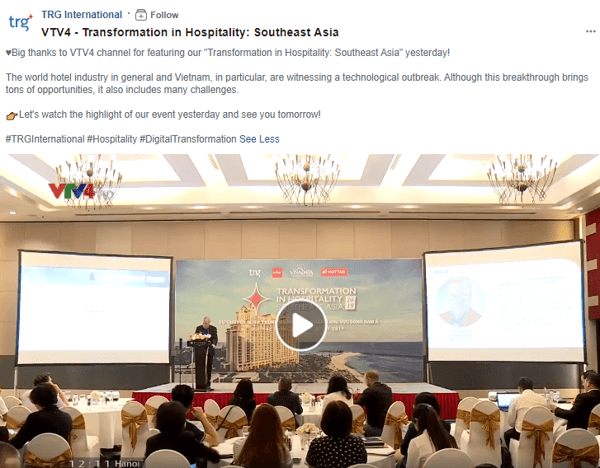
3. Reinforce employer brand with event branding
Our Event Marketing team at TRG frequently organises events with topics revolving the latest buzz in talent management, technology, and project management. We name our events “TRG Talk,” which take place right at our office in District 2.
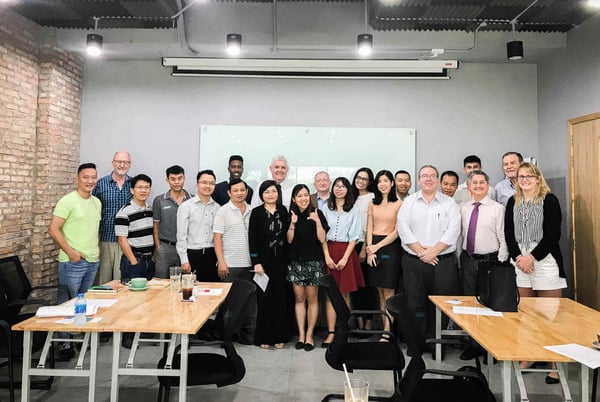
Speaker and attendees at one of our TRG Talks on Project Management
Our Talks are open for the public to join, and we always welcome new speakers to join our network and speak at our events.
TRG also frequents career fairs and career days hosted by universities in Ho Chi Minh City, most recent were at RMIT University, International University, and Vietnamese-German University. We even organise our own Career Day to attract talents for our F&B brand, and we have a dedicated section on our website for our interns to express their experience or general information an intern needs to know when coming to work at TRG.
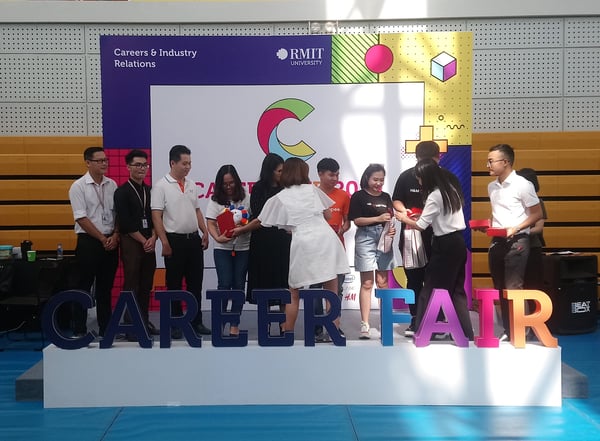
TRG at RMIT University Vietnam Career Day
4. Make the brand more attractive with Corporate Social Responsibility (CSR) activities
CSR activities, when done right, can help your company to reinforce your core values, gain exposure, and keep your employees engaged.
Many choose to participate in annual charity events hosted by AMCHAM, BBGV and CANCHAM, such as the BBGV Fun Run and the Terry Fox Run, which are open to the public. TRG members really enjoy being a part of these fun runs and always participate when there are opportunities.
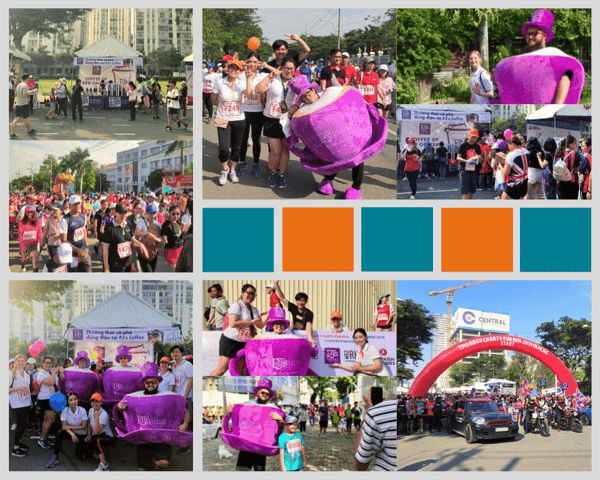
TRGers and PJers at a BBGV Fun Run for Charity
We also take part in donating blood regularly through various programs organised by business chambers in Vietnam in conjunction with Blood Transfusion Haematology Hospital of Ho Chi Minh City.
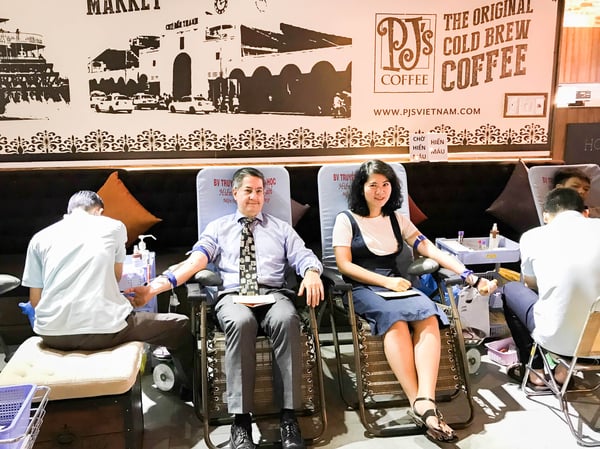
TRG Founder and CEO, Rick Yvanovich, donates blood at least once a year
Every year, our CSR team also takes some time away from our busy schedules to arrange a charity trip to deliver food and other essentials to families in need in remote areas around Vietnam. Our latest trip was to Dak Phoi province in Dak Lak right before the Tet holidays.

Charity trip to Dak Lak
5. Corporate internal events also matter
Many overlooked the benefits of internal employer branding. Internal events can increase engagement, support interpersonal relations, and help you to acquire feedback.
For example, to close the gaps between employees and managers, TRG creates a budget for birthdays, project wrap-ups or other celebrations.
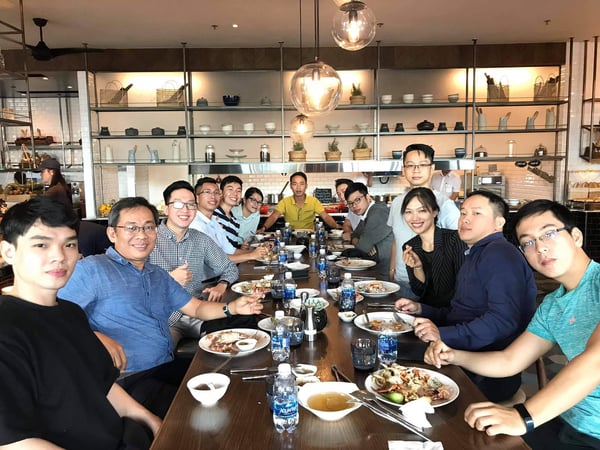
Team dinner of TRG Deliver team
Team building exercises and activities are also great examples of internal events. Team building activities do not need to be limited to a one-day trip to somewhere, or a workshop about team engagement.
You can add your own flair into these exercises to make it suit your company image. For example, at our Team Building last year, TRG had a series of “warm-up” activities where the entire organisation was mixed up and divided into six groups. Each week, one group would announce a challenge and the remaining groups had to accomplish the challenge within the time limit.
The Team Building Committee also tasked all six groups with the responsibility to decorate the company to celebrate Tet holidays.
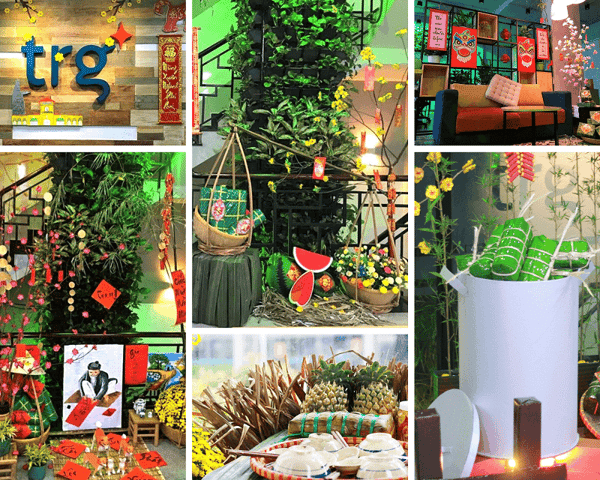
Tet decorations - One of the various team building challenges at TRG
As you can see, these are simple yet fun activities, and the Team Building Committee empowered everyone to unleash their inner creativity, allowed everyone to take charge of an exercise.
II. Build an agile company culture
Google is famous for their products as well as their culture. It is no doubt that Google is one of the most sought-after employers. When talking about the organisational culture, employees at Google comment that "the company still feels like a small company with an informal atmosphere." Google makes changes daily, and not all of those changes are impressive or positive, but they are okay with them.
Company culture, or organisational culture, is a set of values, beliefs, practices shared among all members of the organisations. In other words, culture is the personality of the company, and it defines the environment in which your employees work.
Cultural fit is so critical that 88 per cent of respondents in a Jobvite survey stated that it is one of the vital elements used to assess job candidates. Cultural fit even ranks higher than previous job experience by one per cent in the same survey.
When employees fit in well with the culture of your company, not only are they happier when coming to work, they are also more productive and are willing to stay with you longer. Company culture acts as a foundation to build your employer brand as it directly impacts and reflects your employees' behaviours.
At TRG, our culture is reflected through our six core values:
- Passion
- Integrity
- Innovation
- Coaching culture
- Collaboration
- Kaizen
We believe that passion is the key to success. To maintain our passion, we strive to inspire others as well as ourselves to make gradual improvements day by day. We embrace the mantra of life-long learning, open collaboration, and utmost honesty.
Read more: How to foster diversity and inclusion through internship programs
1. Communication is king
Nothing is more detrimental than poor communication. And the quality of internal communication often says a lot about an organisation. With the increase in social media usage today, many businesses implement social intranet networks that feature social media “look-and-feel” functions, such as give a reaction, comment, tag people, follow, etc.
TRG designs our internal system, which displays all the contact information of our staff for easy lookup. Furthermore, we utilise Microsoft Teams to as the main communication platform where we can chat privately or in groups, schedule online meetings, share documents, make announcements, and more.
Our CEO, Mr Rick Yvanovich, arranges Employee Briefing sessions, a weekly catch up between management and every TRGer online, to provide a platform for anyone, from any department to ask questions, raise concerns, or share their thoughts and get immediate response from Rick.
We do maintain traditional communication between management and employee with our monthly newsletter, which we call “Evolution.”
2. Frequent feedback, instant response
Feedback, especially when given regularly, is essential to promote innovation and improvement. Feedback from managers in addition to acting as a guideline can also help to identify issues that are keeping the team from reaching a goal.
Cargill, a food producer and distributor, headquartered in Minneapolis, introduced the “Everyday Performance Management” system back in 2012 to encourage on-the-job conversations. As a result, they have seen considerable improvements from feedback that was more forward-looking instead of using information and metrics from the past.
You may have heard of OKRs, the objectives and key results goal-setting system. What you may not have known is this system before became widely used was initially originated from Intel and then introduced to be applied in Google by John Doerr.
With a simple formula for execution, the OKRs system is different from KPIs in which it makes the company’s objectives more understandable and helps to align the employees’ work and goals with the corporate vision.
III. Engage the workforce with a healthy working environment
Establishing and maintaining a pleasant physical and psychological working environment is one of the foundational elements in ensuring the employees are happy and productive at the office.
Your ideal working environment can substantially different from what your colleagues, acquaintances or others perceive. Some find comfort in a traditional, more formal setting, while some prefer the open office structure.
Obviously, an office overhaul might be too much to handle, but you can make improvements, starting with promoting a work-life balance, for example, to improve the psychological aspect. Or you can adopt the “sustainability” mantra into the office, turning your average workplace into a greener, more eco-friendly space. This is what TRG did, and as a result, we were awarded the “Green Office Diploma” by the WWF in 2012.
1. Opportunities to learn and grow professionally
Employee training is essential to maintain competitiveness, to help employees to adapt quickly to changing the environment.
Take a look at Yelp. They employ only two practices: (1) put people in stretch roles, and (2) promote internally. Sixty per cent of Yelp’s workforce is salespeople; many are inexperienced or has never worked in sales before.
Yelp focuses on the long-term development of their employees, and by promoting internally (a fact that is emphasised during the onboarding process), the business successfully harbours a culture of mentoring.
Many organisations and even employees neglect the training and developing phases due to many reasons, most popular being:
- People generally are busy;
- They don’t find the training courses relevant to their field of work;
- The training is not applicable in reality.
Considering all the possible scenarios, TRG employs the e-learning method in addition to on-the-job training and coaching. Every employee joining the company will be able to create an online learning account on Udemy and Hubspot Academy so they can learn about practically any skill during their free time. At our office, we also have bookshelves with books from experts in various industries for everyone to check out.
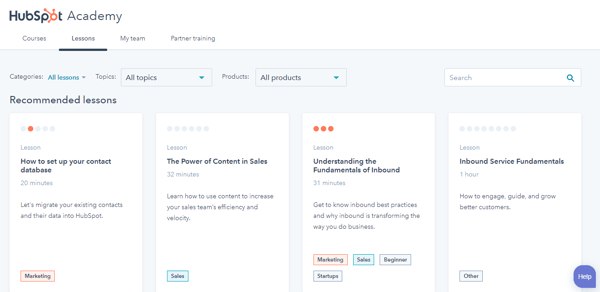
Hubspot is our Marketing e-learning portal
Three years ago, we proposed an individual development initiative for all TRGers. In short, it is a plan which each individual is requested to fill out at the end of the year, detailing specific skills and career goals that they expect to gain.
The completed plan will act as a foundation for managers to design a development plan catered specifically to each employee.
2. Digital transformation in the workplace
For businesses to stay afloat, thrive, and grow in today’s economy requires them to embrace digital transformation. Companies, regardless of size, are working to leverage technology to stay agile and to adapt to the rapidly changing market quickly.
While embracing and utilising technology is essential, transformation is not just about technology. Having a digital culture that is agile and inspiring is equally critical in helping to attract, retain, and engage top talents.
That is also what our teams at TRG are aiming to achieve; we want to build a digital workplace to improve our productivity and a digital culture that is inspiring. Our team members are encouraged to try out different IT solutions to see which one is the most efficient in eliminating redundant, manual processes.
We implement dedicated solutions for each department to support their daily operations, such as a CRM system for our Customer Service team, a Content Management System for our Marketing team, a Project Management Software for PMO division.
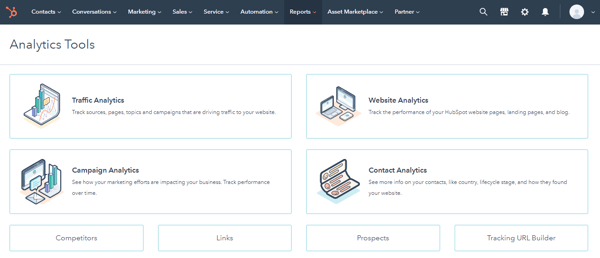
TRG uses Hubspot to manage our Content function
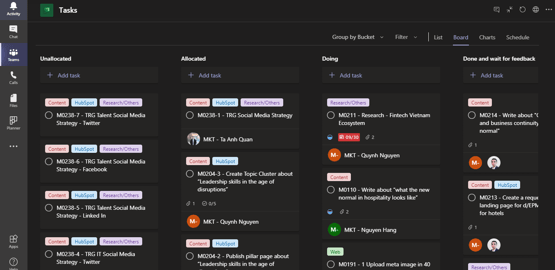
Task Management using Microsoft Teams
3. Acknowledge employee contributions
Praise and recognition are great ways to motivate your employees. Everyone wants to be respected and acknowledged for a job well done. Most of the time, the once a year performance review is not enough. Even a small congratulations to validate your team’s effort can go a long way.
Appreciation is the top factor for happiness in the workplace; rewards and recognition are viewed by many are the strongest driver of engagement.
TRG makes an effort in letting our team members know that their hard work is appreciated. We set up “kudos walls” throughout the office where anyone can write any comments, or kudos, onto a wall to complement an individual and a team.
We also organise Employee of the Month party each month, and subsequently, choose from the existing monthly winners the most outstanding individuals for the Employee of the Year and Rookie of the Year awards at our annual Year-End Party.
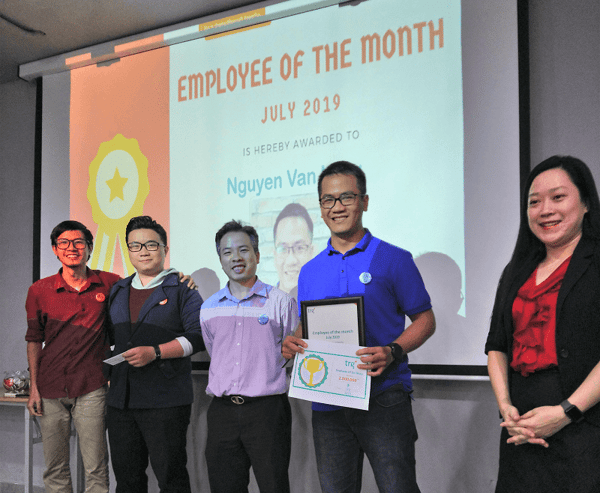
One of our Employee of Month celebrations
We believe this to be a catalyst to build a healthy competitive environment for all of us at TRG.
Does this sound like the type of environment that you have been looking for? Why not work for us? Our teams at TRG International are looking for talented individuals like you. Check out our currently available positions via the below link.
 English
English  Vietnamese
Vietnamese 

